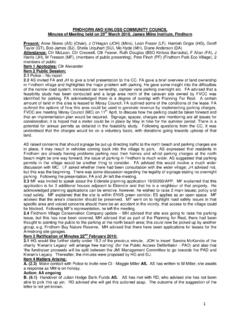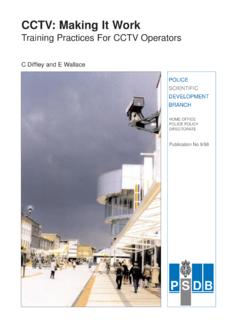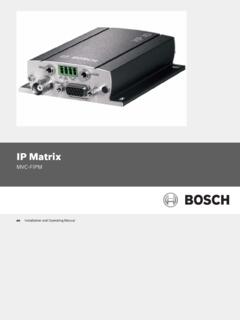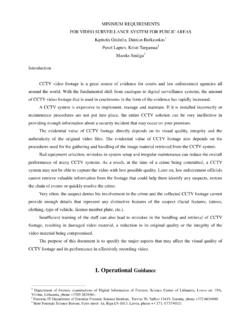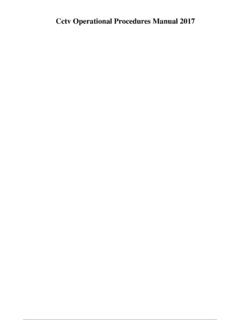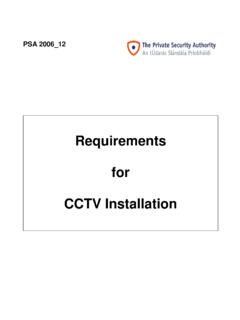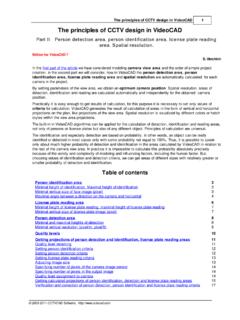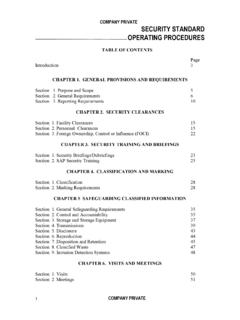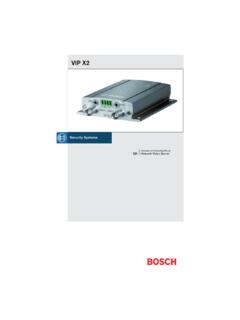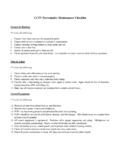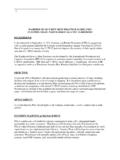Transcription of CCTV SPECIFICATION LICENSED PREMISES - Moray
1 NOT PROTECTIVELY MARKED cctv SPECIFICATION LICENSED PREMISES NOT PROTECTIVELY MARKED 1 NOT PROTECTIVELY MARKED INTRODUCTION Amendments to the Liquor Licensing Act in Scotland came into force in February 2008. A condition of regular extended hours beyond 0100 hours now includes mandatory cctv provision to the satisfaction of the Chief Constable in certain defined, late night opening PREMISES . This SPECIFICATION documents the minimum requirements for cctv systems to meet licensing requirements in the Grampian Police area. This SPECIFICATION does not preclude additional cameras or features that may be added to the cctv system as the management of the PREMISES sees fit, as long as these additional features comply with relevant legislation.
2 Grampian Police recognises that the area of cctv is a dynamic one and that due to advances in technology this SPECIFICATION will require to be reviewed on a regular basis. This is to ensure the ongoing sufficiency of minimum standards set out herein and that these standards continue to uphold the Licensing Objectives of Preventing Crime and Disorder, Securing Public Safety and Preventing Public Nuisance. REFERENCES Within this SPECIFICATION , reference is made to Home Office and Information Commissioner Documents, these should be read in conjunction with this SPECIFICATION (see Section 11). DATA PROTECTION ACT Notwithstanding any of the requirements contained in this document, systems MUST comply with the requirements of the Data Protection Act.
3 It is the responsibility of the PREMISES owner to ensure this requirement is complied with. NOT PROTECTIVELY MARKED 2 NOT PROTECTIVELY MARKED CAMERA POSITIONS Required: All points of entry to or exit from the PREMISES must be captured by at least 1 fixed cctv camera. Required: The cameras should be either tamper resistant or mounted in a way that makes them tamper resistant. Required: Such cameras (Points and ) must have lip-synched audio capture capability. Advised: Further cctv cameras are installed to cover external areas where patrons may be required to wait in line or congregate adjacent to points of entry.
4 Audio capture is not mandatory for these additional cameras, however should be considered for the protection of staff and as an evidence gathering tool where operational requirements dictate. Advised: cctv cameras to cover other internal areas of high footfall and low supervision, including customer/staff interaction areas, bars, counters etc. Audio capture should be considered where needs dictate for the protection of staff and as an evidence gathering tool. Information: All cameras covering areas of high footfall or customer staff interaction areas should give clear 'identifiable' images of all persons as defined in the 'Home Office cctv operational requirements manual '.
5 The cctv coverage of these advisable areas is not mandatory, but recommended. LIGHTING Required: Lighting of sufficient luminance must be installed to fully support cctv cameras at points of entry/exit. Required: At points of entry or exit the lighting must be sufficient (preferably white light) so that the perception of colour is relatively accurate (a minimum value of 60 on the Colour Rendition Index is advised). Advised: Flat consistent illumination to reduce shadowing. NOT PROTECTIVELY MARKED 3 NOT PROTECTIVELY MARKED RECORDING Required: All cctv cameras are to be recorded on digital video cctv recorder(s).
6 Required: Good quality cctv images must be captured with a minimum image capture rate of 12 frames per second and a minimum resolution of 2 CIF. Required: The recorder must be capable of continued recording when replay of images takes place. Required: Images must be retained for a period of 7 to 14 days and should then be overwritten. Where evidence is retained for use by a Law Enforcement Agency this period may be longer. It is recommended that any footage transferred to disc (or other media) be tested before handover to Officers. Advised: If a greater retention period is chosen it should reflect the organisations' own purposes and should be the shortest possible based on experience (Reference: The Information Commissioner's cctv Code of Practice).
7 Advised: A system of loss-less compression should be considered and would be recommended (Reference: Home Office cctv operational requirements manual ). IMAGE RETRIEVAL Advised: Crown Office and Procurator Fiscal Service (COPFS) has stipulated that the acceptable standard for presentation of digital evidence in Court is PAL DVD compatible. Though not mandatory, it is recommended that systems are able to output to this format. Required: If the requirement of above is not possible, retrieval of images from the digital video recorder must meet the following requirements : 1. The evidence must be able to be exported from the digital video recorder to one or more of the following media: USB2 hard drive DVD CD NOT PROTECTIVELY MARKED 4 NOT PROTECTIVELY MARKED 2.
8 The evidential image file must be accompanied on the export media (Hard drive, DVD or CD) by its playing software to be viewed in the format in which it was originally recorded. 3. The playing software must be licence free. 4. The playing software must be playable on the Windows XP operating system. 5. The playing software and evidence must be playable from the media (Hard drive, DVD or CD) on which it is recorded and must not require installing, or any component part, on the PC on which it is played. 6. The playing software must not require access to the registry of the computer on which it is played. 7. The evidence must be saved without password protection.
9 IMAGE VIEWING Required: The cctv system must include a method for viewing and reviewing images. This should be a 17" cctv monitor or better, which can be switched to view each cctv camera individually. Required: The set-up and performance of each entry/exit camera must be easily confirmed. Required: All point of entry or exit cameras must give clear 'identifiable' images of all persons as defined in the Home Office cctv operational requirements manual . Required: All images captured must be clear, easily viewed and of sufficient quality to be used as evidence in Court.
10 Advised: The layout of the door entry arrangements should be such as to provide Pinch Points that will assist the cctv system achieving consistent 'identifiable' images. These Pinch Points must not be achieved at the expense of Health and Safety considerations. NOT PROTECTIVELY MARKED 5 NOT PROTECTIVELY MARKED TRAINING Required: Sufficient staff must be trained in the operation of the cctv system, and at least one member of staff who is able to retrieve images for evidential purposes should be on duty at all times. This is necessary to comply with the terms of the Data Protection Act and failure to comply may invalidate insurance.

